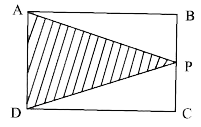Area of triangle
To find the area of a triangle given its vertices using determinants, we can follow these steps:
1. Identify the Coordinates of the Vertices:
Let's denote the vertices of the triangle as:
- Vertex A: (x1,y1)
- Vertex B: (x2,y2)
- Vertex C: (x3,y3)
For this example, we have:
- A(5,4)
- B(−2,4)
- C(2,−6)
2. Set Up the Determinant Formula:
The area Δ of triangle ABC can be calculated using the formula:
Δ=12∣∣
∣∣∣∣
∣∣x1y11x2y21x3y31∣∣
∣∣∣∣
∣∣
3. Substitute the Coordinates into the Determinant:
Now, substituting the coordinates into the determinant:
Δ=12∣∣
∣∣∣∣
∣∣541−2412−61∣∣
∣∣∣∣
∣∣
4. Calculate the Determinant:
We will calculate the determinant using the formula for a 3x3 determinant:
∣∣
∣∣abcdefghi∣∣
∣∣=a∣∣∣efhi∣∣∣−b∣∣∣dfgi∣∣∣+c∣∣∣degh∣∣∣
Applying this to our determinant:
=5∣∣∣41−61∣∣∣−4∣∣∣−2121∣∣∣+1∣∣∣−242−6∣∣∣
Now calculating each of the 2x2 determinants:
- ∣∣∣41−61∣∣∣=(4⋅1)−(1⋅−6)=4+6=10
- ∣∣∣−2121∣∣∣=(−2⋅1)−(1⋅2)=−2−2=−4
- ∣∣∣−242−6∣∣∣=(−2⋅−6)−(4⋅2)=12−8=4
Substituting these back into the determinant:
=5(10)−4(−4)+1(4)=50+16+4=70
5. Calculate the Area:
Now, substituting back into the area formula:
Δ=12|70|=702=35
Final Answer:
The area of the triangle is 35 square units.
---
Let's denote the vertices of the triangle as:
- Vertex A: (x1,y1)
- Vertex B: (x2,y2)
- Vertex C: (x3,y3)
- A(5,4)
- B(−2,4)
- C(2,−6)
The area Δ of triangle ABC can be calculated using the formula:
Δ=12∣∣
∣∣∣∣
∣∣x1y11x2y21x3y31∣∣
∣∣∣∣
∣∣
Now, substituting the coordinates into the determinant:
Δ=12∣∣
∣∣∣∣
∣∣541−2412−61∣∣
∣∣∣∣
∣∣
We will calculate the determinant using the formula for a 3x3 determinant:
∣∣
∣∣abcdefghi∣∣
∣∣=a∣∣∣efhi∣∣∣−b∣∣∣dfgi∣∣∣+c∣∣∣degh∣∣∣
Applying this to our determinant:
=5∣∣∣41−61∣∣∣−4∣∣∣−2121∣∣∣+1∣∣∣−242−6∣∣∣
- ∣∣∣41−61∣∣∣=(4⋅1)−(1⋅−6)=4+6=10
- ∣∣∣−2121∣∣∣=(−2⋅1)−(1⋅2)=−2−2=−4
- ∣∣∣−242−6∣∣∣=(−2⋅−6)−(4⋅2)=12−8=4
=5(10)−4(−4)+1(4)=50+16+4=70
Now, substituting back into the area formula:
Δ=12|70|=702=35
The area of the triangle is 35 square units.
Similar Questions
Consider the following statements :
1. Let D be a point on the side BC of a triangle ABC: If area of triangle ABD = area of triangle ACD, then for all points O on AD, area of triangle ABO = area of triangle ACO.
2. If G is the point of concurrence of the medians of a triangle ABC, then area of triangle ABG = area of triangle BCO = area of triangle ACG.
Which of the above statements is/are correct?
View SolutionABC is a triangle in which D is the midpoint of BC and E is the midpoint of AD. Which of the following statements is/are correct?
1. The area of triangle ABC is equal to four times the area of triangle BED.
2. The area of triangle ADC is twice the area of triangle BED.
Select the correct answer using the code given below.
View Solution
Knowledge Check
ABCD is a square . Draw a triangle QBC on side BC considering BC as base and draw a triangle PAC on AC as its base such that ΔQBC~ΔPAC. Then, Area of ΔQBCArea of ΔPAC is equal to :
A12B21C13D23ABCD is a square. Draw an equilateral triangle PBC on side BC considering BC is a base and an equilateral triangle QAC on diagonal AC considering AC is a base. Find the value of
Area of ΔPBCArea of ΔQAC.A12B1C13D14ABC is a triangle with base AB. D is a point on AB such that AB = 5 and DB = 3. What is the ratio of the area of ΔADC to the area of ΔABC ?
A3/2B2/3C3/5D2/5
ABCD is rectangle. P and Q are points on ABandBC respectively such that the area of triangle APD=5, area of triangle PBQ=4 and area of triangle QCD=3, all areas in square units. Then the areaof the triangle DPQ in square units is
View SolutionArea of a triangle
View SolutionArea of quadrilateral ABCD =Area of ΔABC+ area of _______
View SolutionIf area of Parallelogram ABCD is 80cm2 Find the area of ΔAPD.

View SolutionFind the area of Fig.34 in the following ways: Sum of the areas of three triangles Area of a rectangle - sum of the areas of five triangles
View Solution
